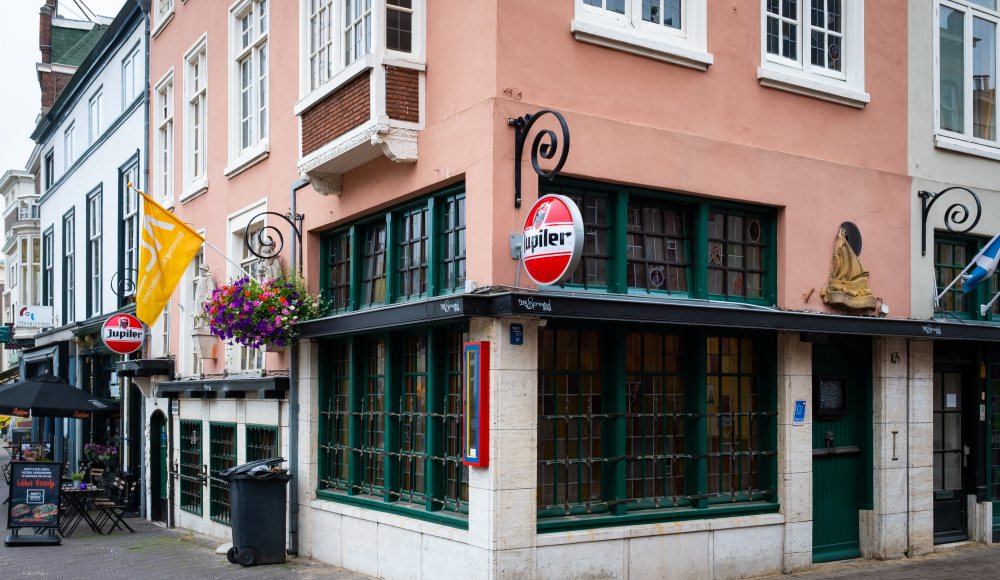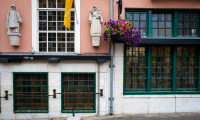


If you walk out of the cozy and bustling Noordeinde with its many shops and galleries, you will see the former inn De Groene Valck at the end of the street on the right. For years this was the name of the stately building at Noordeinde 165, where food, drink and entertainment have been the order of the day since 1630.
It is almost impossible to imagine, but the city once ended at the head of the Noordeinde. This was the northern gateway to The Hague. Scheveningen fishermen passed through here to sell their fish on the market in front of the Old Town Hall. They covered great distances – often on foot – through the dune sand and across the Zandslag, which is now called Zeestraat. When they went back, they took peat with them.
Scheveningen ferry
From Scheveningen you had to cross the water to enter the city. In 1681 there was already a drawbridge over the Singelgracht here. A coach service brought travelers from The Hague to Scheveningen: it was called the Veer. The name of the piece of street where Noordeinde ends, Scheveningseveer, is still a reminder of this.
Inn from 1630
Here on the corner is one of the oldest inns in The Hague, which was called De Groene Valck when it was founded. The low door on the side of the Scheveningseveer is the entrance to what was called the Prinsekelder not long ago. Above this door is the year 1630, when the inn opened its doors, but documents mention this building for the first time as early as 1592. Otto van Steensel bought the land on the stream for the construction of two houses. Initially they were residences, until in 1630 the De Groene Valck inn appears for the first time in a deed. Above the door is a statue of a prince on a horse, with a green falcon on his shield.
Busy business
The business must have been going well, especially when the connection with Scheveningen improved considerably in 1653 due to the construction of the Scheveningse Zeestraet, which was later called the Scheveningsweg. At the head of the Noordeinde, the wagons that transported passengers between the Hague market and the fishing village were waiting. The coachmen and travelers needed a snack and a sip.
Original state
The Noordeinde later became more stately, with larger buildings in a continuous row. De Groene Valck was joined by six more houses on the west side of Scheveningseveer, which included a farrier. During a renovation in 1831, new windows and doors were placed in the facade. In front of the building was a gruttererij. It later disappeared to make way for a place to eat and drink.
The Little White
In 1881 De Groene Valck was renamed De Kleine Witte. This probably refers to the 'big' Witte, the gentlemen's club that still thrives on the Plein in the city center. Coachmen who had brought a customer there could wait at De Kleine Witte while enjoying a snack until they could pick up their passenger again. The owner at the time was A.J. Prins, whose descendants still ran the catering facility until recently under the name Taveerne De Prins. One of them, Pieter, had the establishment restored.
When Princess Juliana got engaged to Prince Bernhard in 1936, this was the ideal location for a lavish party. So exuberant, in fact, that the 300-year-old trusses began to crack and again an architect had to be involved to carry out a restoration. Co Brandes was recruited for this. The current building has therefore been renovated and modernized several times.
Images of Dirk Bus
The facade was then tackled by H. Lelie, who had sculptures applied against the facade on Scheveningseveer, made by the Hague sculptor Dirk Bus (1907-1978). They are reminiscent of the inn's connection with the fishing village: we see a fisherman in an oil coat with a southwesterly on his head and a fish as fat loot in his hand, and a woman with her baby on her arm, peering out over the sea and waiting on the boat with her husband and the catch on board. On the Noordeinde side, a sailboat is bobbing on the facade. With such references, Scheveningen is never far away.

